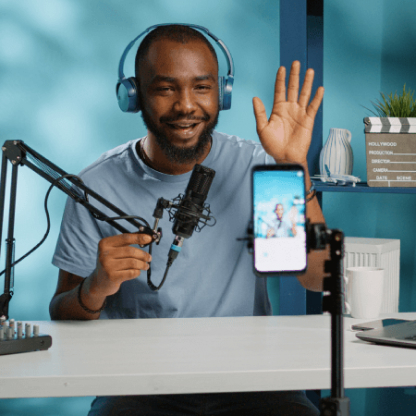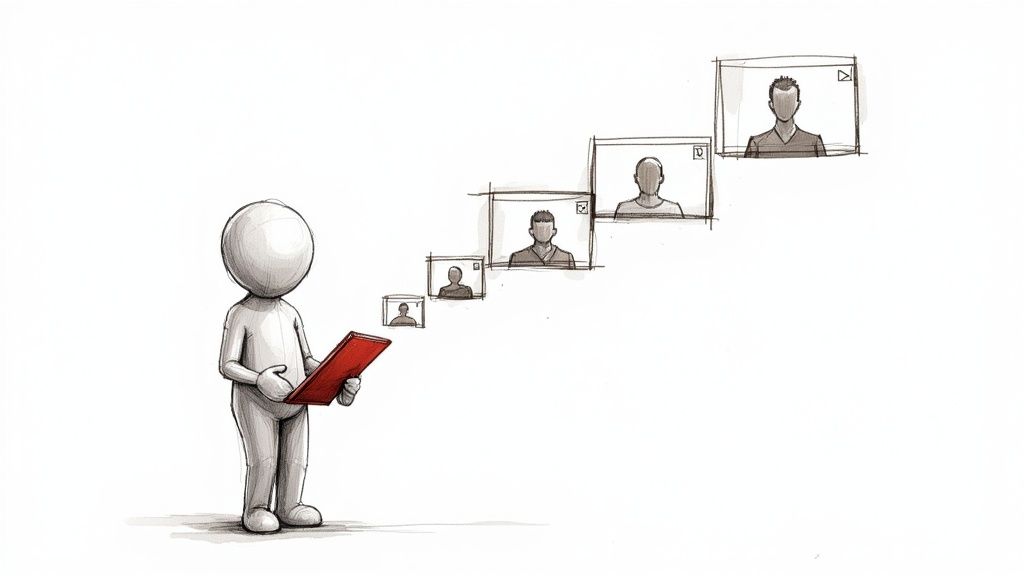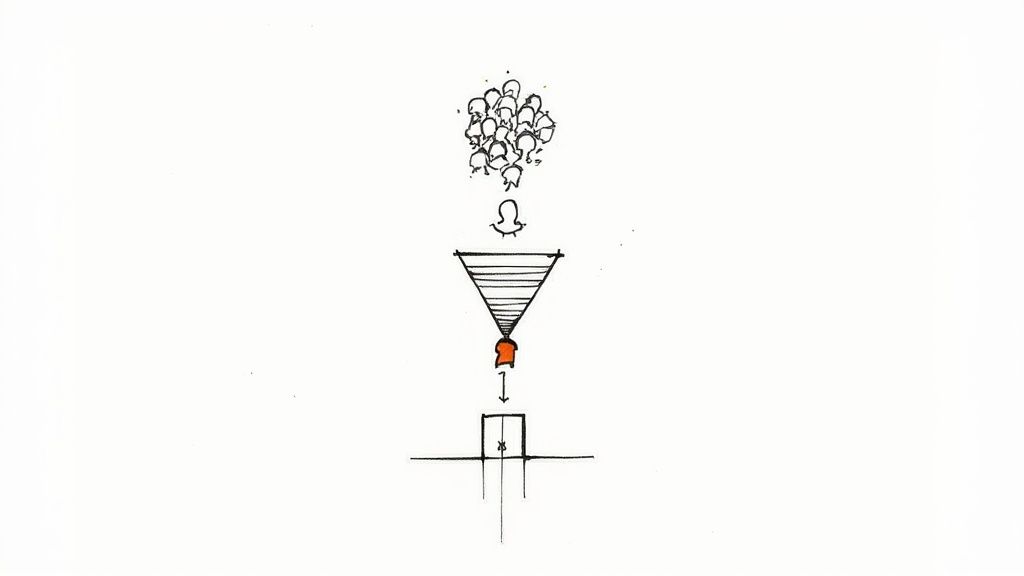Let's be honest, the initial screening call is broken. It's a time-suck that fills your calendar with back-to-back conversations that mostly go nowhere, forcing you to ask the same five questions on repeat. This isn't just annoying; it's expensive.
The Hidden Costs of Traditional Screening Calls
Every founder knows the grind. Your calendar looks like a game of Tetris gone wrong, packed with 30-minute screening calls. You spend hours listening to canned answers, only to realize five minutes in that it’s a hard "no."
This isn't just an inefficient process; it's a catastrophic waste of your most valuable resource: time. Every hour you or your senior engineer spends on a dead-end screening call is an hour you’re not building the product, talking to customers, or closing a deal.
The Real Price of "Just a Quick Chat"
We love to pretend these calls are free, but the opportunity cost is staggering. I've been there. We once spent two weeks screening candidates for a lead role. On paper, one guy was a rockstar. In the screening call? He couldn't articulate a single original thought beyond his resume bullet points.
That was 30 hours of our senior team's time down the drain, chasing a dead end.
You're not just losing time; you're losing momentum. Hope you enjoy spending your afternoons fact-checking resumes and running technical interviews—because that’s now your full-time job. This initial step in the hiring process, what we call pre-screening, has to be smarter. For a deeper dive, check out our guide on what is pre-screening and why it's critical.
The true cost of a bad screening process isn't the recruiter's salary—it's the lost innovation, the delayed product launches, and the slow erosion of your competitive edge.
More Than Just Annoying—It's Unsustainable
Sticking with old-school phone screens is like insisting on using a flip phone in a world of smartphones. It technically works, but you're falling behind with every call you make. The inefficiency compounds, forcing you to choose between slowing down growth or burning out your best people.
Eventually, you have to find a better way before you end up mortgaging the office ping-pong table to cover recruiting costs. To further optimize your hiring budget and overall efficiency, explore strategies to reduce operational costs that go beyond just hiring. It's time to stop the bleeding.
Understanding Pre Recorded Video Interviews
So, what’s the alternative to the calendar Tetris of endless screening calls? Pre recorded video interviews. Or "async interviews" if you want to sound like you’re in the know.
Forget everything you think you know about HR tech. This isn't some futuristic robot interrogator. It's actually dead simple.
Think of it like leaving a detailed voicemail for your top candidates. You send a set of well-crafted questions, and they record their answers on their own time. No scheduling, no no-shows, and absolutely no awkward small talk about the weather.
It's a one-way video interview that puts both you and the candidate back in control. They get to prepare thoughtful answers without the pressure of a live call, and you get to review submissions whenever it fits your schedule—like at 10 PM after the kids are asleep.
How It Actually Works
The process is straightforward for everyone involved. From your side, you just need to:
- Craft Your Questions: Write the handful of questions that really matter for the initial screen.
- Send the Invite: Email a unique link to your applicants.
- Review and Collaborate: Watch the video responses and share them with your team for feedback.
This simple infographic visualizes the core benefit of this approach—reclaiming your time while maintaining hiring quality.
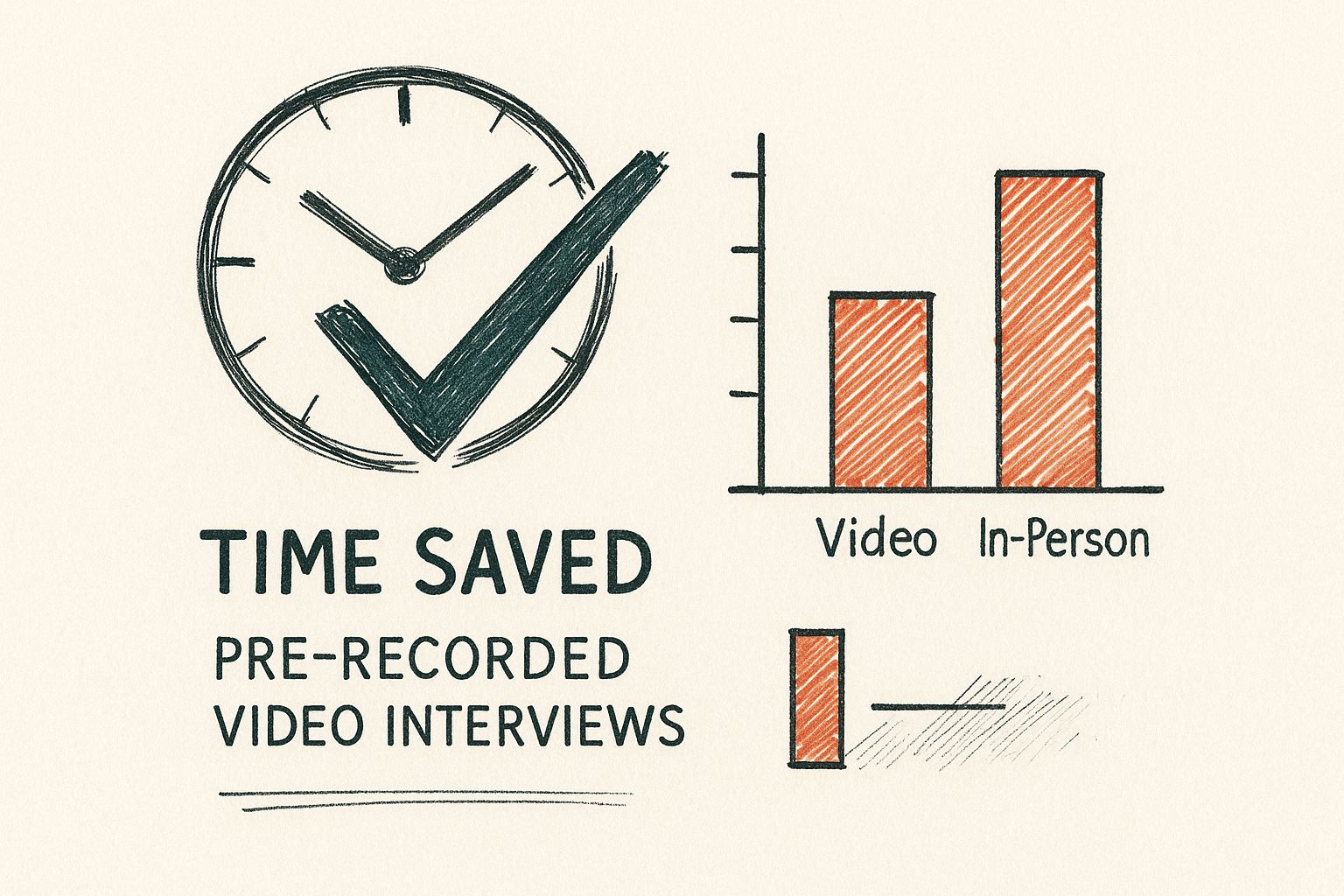
The image perfectly captures the goal: maximum efficiency with a clear checkmark on quality. This isn't about cutting corners; it's about being smarter with your resources.
But how does this stack up against the old-school phone screen? Let's break it down.
Traditional Screening vs Pre Recorded Interviews
| Factor | Traditional Phone Screen | Pre Recorded Video Interview |
|---|---|---|
| Scheduling | Requires back-and-forth emails, calendar coordination, and finding mutual availability. | No scheduling required. Candidates respond on their own time. |
| Time Commitment | 30-60 minutes per candidate, plus scheduling and prep time. | 5-10 minutes to review each candidate's submission. |
| Consistency | Questions and tone can vary between interviewers and even between calls. | Every candidate gets the exact same questions, ensuring a fair and consistent process. |
| Collaboration | Relies on one person's notes and recollections to share feedback with the team. | Video responses can be easily shared, reviewed, and rated by multiple team members. |
| Candidate Experience | Puts candidates on the spot, often with little time to prepare thoughtful answers. | Gives candidates the flexibility to prepare and record answers when and where they feel most comfortable. |
As you can see, the shift is pretty dramatic. It’s not just about saving time; it's about creating a more structured, fair, and collaborative screening process from the very start. Ultimately, it’s a practical tool that feels less like a corporate process and more like a focused, asynchronous conversation designed to find the right fit, faster.
Strategic Benefits Beyond Saving Time
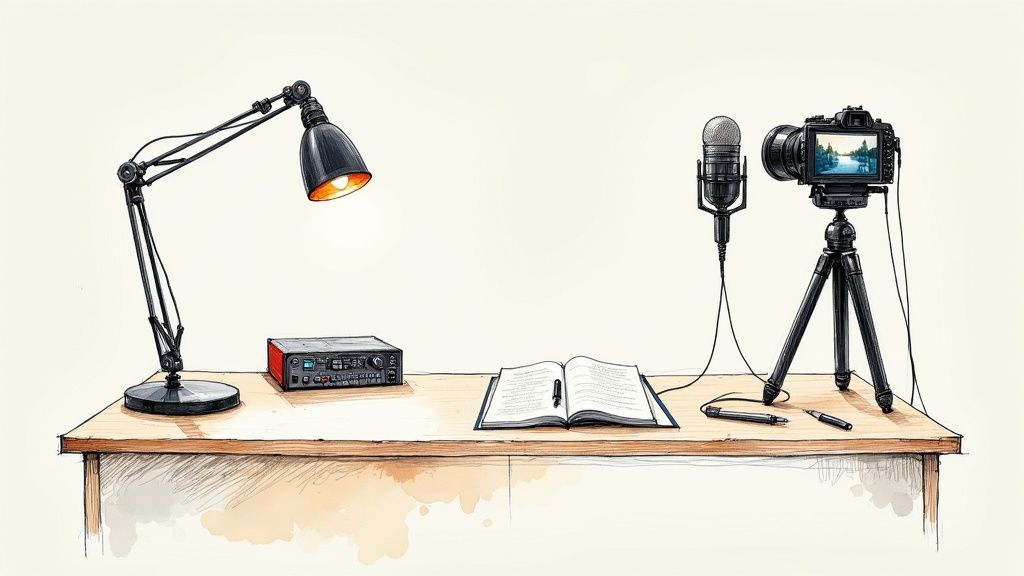
Look, everyone knows pre-recorded video interviews save time. It’s the headline on every sales brochure and the first thing any demo jockey mentions. And while that's absolutely true, focusing only on the time savings is like buying a smartphone just to make calls—you're missing the real magic.
The biggest wins aren't about shaving a few hours off your calendar. They're about fundamentally changing how you hire for the better. We’re talking about tangible, operational improvements that lead to smarter, fairer, and more defensible hiring decisions.
Apples to Apples Comparison Every Time
Let’s be honest about consistency. When you're grinding through back-to-back phone screens, your energy dips, your questions drift, and your mood changes. The candidate you speak with at 9 AM gets a different interviewer than the one at 4 PM. It’s just human nature.
Pre-recorded video interviews put a stop to that. Every single candidate gets the exact same questions, delivered in the exact same way, with the same tone. This structured approach is your secret weapon against the unconscious bias that always finds a way to creep into live conversations.
You’re no longer comparing your memory of a conversation with your gut feeling about another. You’re comparing structured, identical datasets. It’s the difference between guessing and knowing.
This method gives you a truly fair way to compare applicants, letting you evaluate them on actual skills and competencies, not on subjective whims. It’s a huge leap forward in creating a level playing field.
Deeper Insights and Killer Collaboration
A 20-minute phone call barely scratches the surface. You get a rushed summary of a resume and maybe one decent answer. An async interview, on the other hand, gives candidates the space to actually think and articulate their thoughts properly.
You get to see how they structure an argument, how they communicate complex ideas, and a glimpse of their actual personality—not their stressed-out, on-the-spot phone screen persona.
But the collaboration part? That's the real game-changer.
- No More "He Said, She Said": Instead of trying to relay your "gut feeling" in a Slack message, your co-founder can watch the exact same interview you did and form their own opinion.
- Asynchronous Reviews: Your lead engineer in another time zone can review candidates when it works for them, adding notes directly to the video timeline.
- A Single Source of Truth: The interview becomes a central asset that the entire hiring team can reference, discuss, and score against a unified rubric.
This isn’t just about making things quicker; it's about building a robust, defensible hiring engine. When you start exploring broader strategies for automation in talent acquisition, you'll see how these tools can transform your entire funnel from top to bottom. It’s how you finally stop making gut calls and start making data-backed decisions.
Our Playbook for Finding Top Talent
Alright, theory is great, but it doesn't get jobs filled. Let's get into the weeds. This is our exact, battle-tested playbook for using pre-recorded video interviews—without making top candidates run for the hills.
Forget everything you’ve read in those generic HR blogs. Most of it is fluff written by people who haven’t hired a senior engineer in their life. Our process is built on one simple principle: respect the candidate's time, and they'll respect yours.
The Three-Question Gauntlet
First rule: less is more. Nobody wants to record a ten-part video essay. You'll just get rambling, low-effort responses and scare off the best people. We stick to a strict maximum of three to four questions. Any more than that, and you're just creating busy work for everyone.
The real key is crafting questions that test for multiple things at once. We never ask "tell me about yourself"—that's what the resume and their LinkedIn profile are for. Instead, we use a simple framework that hits the trifecta of technical chops, problem-solving, and culture fit.
Here’s a taste of what we ask our engineering candidates:
- The "Fix-It" Question: "Walk me through a time you inherited a messy codebase. What were the first three things you did, and why?" This tests their diagnostic skills, pragmatism, and ability to handle technical debt without whining.
- The "Disagree and Commit" Question: "Tell me about a technical decision you strongly disagreed with but had to execute anyway. How did you handle it?" This reveals their professional maturity, team dynamics, and ego (or lack thereof).
- The "Passion Project" Question: "Show us something you built for fun outside of work, and explain what you learned from it." This uncovers their genuine passion for their craft and their ability to learn independently.
See the pattern? Each question forces them to tell a story, revealing how they think, communicate, and solve real-world problems.
Setting the Stage for Success
How you present the interview is just as important as the questions you ask. We learned the hard way that a cold, automated email link is a surefire way to look like a faceless corporation.
Now, we always include a short, informal intro video from the actual hiring manager. It’s maybe 60 seconds long and covers three simple things:
- A genuine "hello" and thank you for their time.
- A quick, exciting overview of the problem they'll be solving in the role.
- An explanation of why we use async interviews (to respect their schedule).
This simple human touch changes the entire dynamic. It transforms the experience from a robotic screening test into the start of a real conversation.
We also integrate the process directly into our ATS and have a simple, three-point rubric for the hiring team to score responses. This keeps evaluations objective and fast. No more "I just got a weird vibe" feedback. It’s all about creating a system that’s efficient, fair, and, most importantly, human.
How AI Can Supercharge Your Hiring Process
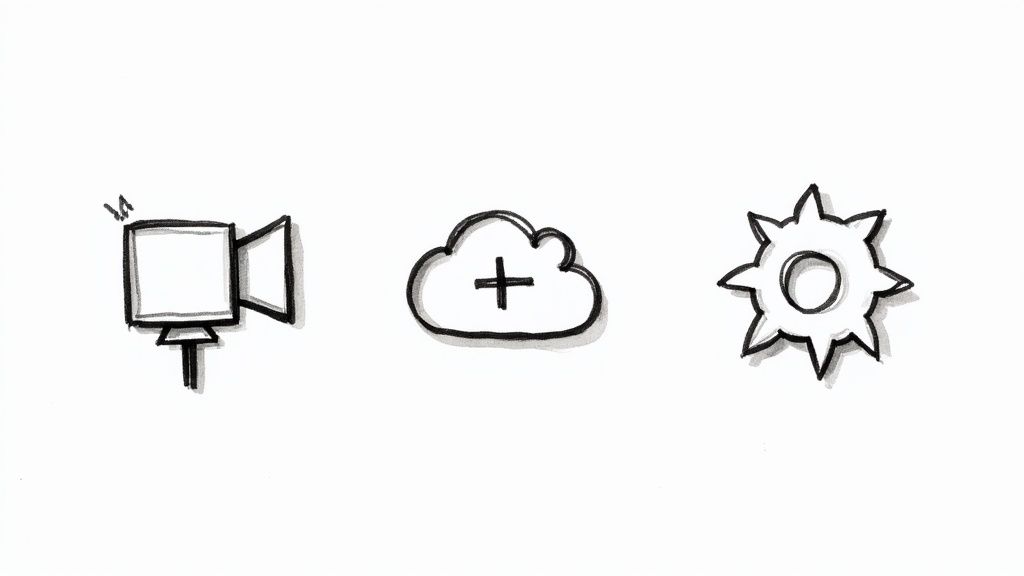
Let’s be real, the term "AI in hiring" sounds a bit dystopian. It conjures up images of HAL 9000 rejecting candidates because their shirt color wasn't in the algorithm. But we're not letting robots make our hiring decisions. That’s not what this is about.
Think of it less like a robotic overlord and more like a super-powered assistant for your recruiting team—one that sifts through the noise so you can focus on the signal. Modern AI isn’t replacing your judgment; it’s giving it a turbo boost.
Beyond Just Watching Videos
The real power here is turning a qualitative gut check into something you can actually measure. Instead of your team spending hours manually watching every single submission, AI can handle the first pass.
It’s about surfacing insights you would have otherwise missed. Good AI tools don't make decisions for you. They arm you with better data so you can make smarter ones. The days of relying on a half-remembered "good vibe" from a screening call are over.
Here’s what a good AI layer on top of your pre recorded video interviews can do:
- Instant Transcriptions: Get a searchable text version of every answer. No more re-watching a five-minute video to find that one key phrase.
- Key Competency Highlighting: You define the skills and keywords that matter for the role, and the AI flags where candidates mention them.
- Sentiment Analysis: Get a high-level view of a candidate's tone and confidence without letting your own biases get in the way.
This isn’t about automating relationships; it’s about automating the grunt work. In fact, AI-assisted screening can reduce manual review time by up to 70%, freeing your team to focus on the high-potential candidates who truly deserve their attention.
The Bias Question (Because It Matters)
Now for the elephant in the room: AI bias. It's a legitimate concern. A poorly designed algorithm can absolutely perpetuate and even amplify human biases. Hope you enjoy defending a hiring decision made by a black box—because that’s what you’ll be doing if you choose the wrong tool.
This is why transparency is non-negotiable. Ethical AI tools are built on clear, explainable criteria that you control. You set the benchmarks. The AI just does the heavy lifting of measuring against them. It’s a tool for consistency, ensuring every candidate is evaluated on the same objective framework.
When used correctly, this technology makes the process faster, more objective, and, ironically, more human. It clears your plate of the tedious tasks so you can spend your time having meaningful conversations with the right people. Our guide on automated candidate screening explores how to implement these systems responsibly.
The Data That Makes This a No-Brainer
Alright, let's cut to the chase. As founders, we live and die by the numbers. ROI isn't some fluffy concept; it's the only thing that keeps the lights on. So, let’s connect the dots between asynchronous interviews and the hard, measurable outcomes that actually move the needle for your business.
This isn't just another "nice-to-have" tool. We're talking about a genuine competitive edge, and it’s backed by cold, hard data. If you’re still spending your days scheduling endless phone screens, you’re not just wasting time—you’re actively leaving money on the table. It feels a bit like using a fax machine in the age of email and wondering why you’re falling behind.
Frankly, the business case is so strong it’s almost insulting to have to spell it out. But let's look at the stats.
From Hours to Minutes, Costs to Savings
The biggest and most immediate win here is the radical drop in time-to-hire. Filling a critical role weeks—not months—faster is a massive lever for growth. When you’re a small team, every empty seat is a bottleneck that grinds your entire operation to a halt.
But the data tells an even more compelling story. A whopping 74% of recruiters say video interviews make it dramatically easier to shortlist candidates. This isn’t a small efficiency tweak; it’s a fundamental change in how quickly you can move. The same report found that 47% of organizations use this tech specifically to slash their time-to-hire, with many shaving off up to 8 days from their hiring timelines. You can dive into the full breakdown of how video interviews impact hiring metrics yourself.
This isn't just about moving faster. It's about reallocating your most expensive resource—your team's time—away from repetitive screening and toward high-value work that actually grows the company.
The Ripple Effect of Better Hiring
And the benefits don't stop at speed. The numbers also show a direct impact on your costs and your access to top-tier talent.
- Direct Cost Savings: Nearly half of all recruiters (45%) confirm that one-way video interviews directly lower their hiring expenses. This comes from fewer hours spent by expensive personnel on low-value calls and, more importantly, making better hires who actually stick around, which cuts down on costly turnover.
- Expanded Talent Pools: About 22% of companies point out that this method opens the door to non-local and remote talent. Suddenly, you're no longer limited to candidates in your immediate zip code, giving you access to a global pool of A-players you could never reach before.
When you add it all up—faster hires, lower costs, better retention, and a much wider talent pool—the argument for sticking with traditional phone screens completely falls apart. The data is crystal clear. The only question left is, why would you keep doing things the old way?
Founders Always Ask…
Look, we get it. We hear the same handful of objections from founders who are on the fence about pre-recorded interviews. You've probably had these thoughts flash through your mind, too. So let's cut to the chase and tackle the big three head-on.
Won't This Scare Away Top Candidates?
Honestly? Not if you do it right. The best candidates aren't scared of a structured process; they're terrified of having their time wasted.
If you position the video interview as a flexible, modern option that respects their packed schedule, they’ll actually appreciate it. The real secret sauce is adding a personal intro video from the hiring manager. It takes all of 60 seconds to record and proves there are real, live humans behind the curtain. Top talent wants efficiency, not fluff.
Isn't It Just… Impersonal?
It absolutely can be, but only if you take a lazy approach—just slapping a generic question template on it and calling it a day. That's a rookie mistake.
The goal isn't to replace human interaction. It's to make the actual human conversations you do have way more meaningful. Think of it this way: a one-way video is less personal than a live call, but it gives you infinitely richer information than a resume. By asking thoughtful, open-ended questions, you get a real glimpse into how a person thinks. This lets you skip the boring resume recap on the "real" call and dive straight into a much deeper, more substantive conversation with your finalists.
How Much Work Is It to Set Up?
Far less than you'd think. The initial setup is surprisingly quick, especially since most platforms plug right into the Applicant Tracking System (ATS) you're probably already using.
Crafting your first set of questions might take an hour, tops. But here’s the kicker: you can reuse that template for every similar role you hire for. That one hour upfront saves you from dozens—literally, dozens—of hours spent on those repetitive, soul-crushing screening calls. The ROI is a no-brainer.
Ready to stop wasting time on dead-end screening calls? Async Interview helps you screen candidates up to 10x faster. Start your free trial today and see how you can get your next great hire in the door, not just stuck on your calendar.
